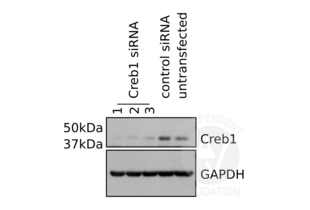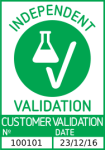CREB1 Antikörper
-
- Target Alle CREB1 Antikörper anzeigen
- CREB1 (cAMP Responsive Element Binding Protein 1 (CREB1))
-
Reaktivität
- Human
-
Wirt
- Maus
-
Klonalität
- Monoklonal
-
Konjugat
- Dieser CREB1 Antikörper ist unkonjugiert
-
Applikation
- Western Blotting (WB), Immunohistochemistry (IHC), ELISA, Immunocytochemistry (ICC)
- Verwendungszweck
- CREB1 Antibody
- Aufreinigung
- Ascitic fluid
- Immunogen
- Purified recombinant fragment of human CREB1 expressed in E. Coli.
- Klon
- 5G3
- Isotyp
- IgG1
-
-
- Applikationshinweise
-
ELISA: 1/10000
ICC: 1/200 - 1/1000
- Beschränkungen
- Nur für Forschungszwecke einsetzbar
-
- by
- Instituto de Parasitología y Biomedicina López-Neyra
- No.
- #100101
- Datum
- 23.12.2016
- Antigen
- CREB1
- Chargennummer
- 110517
- Validierte Anwendung
- Western Blotting
- Positivkontrolle
- primary mouse microglia
- Negativkontrolle
- siRNA knock-down of CREB1 in primary mouse microglia
- Bewertung
- Passed. ABIN969061 specifically recognizes Creb1 in primary mouse microglia lysates.
- Primärantikörper
- ABIN969061
- Sekundärantikörper
- anti-mouse HRP-conjugated antibody (DakoCytomation, P0447, lot 00058737)
- Full Protocol
- Primary mouse microglia are grown in DMEM (Invitrogen), supplemented with 10% foetal bovine serum (Gibco), 10% horse serum and penicillin and streptomycin (Gibco), at 37°C and 5% CO2 in a 12-well dish.
- Transfect cells with 0.05nmol mouse Creb1 Silencer Select siRNA (ThermoFisher Scientific, ASO1093M, ASO10982 and ASO109CG, lot AMO04BXD) using Lipofectamine 3000 (Invitrogen) following the manufacturer’s instructions.
- Lyse cells in 25µl per well cold lysis buffer (10mM Tris-HCl pH 8.0, 150mM NaCl, 1% Nonidet-P40, 1mM EDTA, 10mM NaF, 1mM Na3VO4, containing protease inhibitors (Sigma)).
- Determine total protein content of the lysates using Bradford assay (Bio-Rad, 500-0006, lot 111832).
- Denature 5µg of total protein for 5min at 95°C in 5µl Laemmli SDS sample buffer and subsequently separate them on a denaturing, freshly cast 10% SDS-PAGE for 1h at 140V.
- Transfer proteins onto PVDF membrane (Pall Life Sciences, 75696G, lot TO3225) with a semi-dry Western blotting system for 50min at 60mA.
- Block the membrane with TBST (TBS, 0.1% Tween) containing 5% milk ON at 4°C.
- Incubation with primary mouse anti-CREB1 antibody (antibodies-online, ABIN969061, lot 110517) diluted 1:10000 in TBST containing 5% milk for 1h at RT.
- Wash membrane 5x 5min with TBST.
- Incubation with anti-mouse horseradish peroxidase-conjugated secondary antibody (DakoCytomation, P0447, lot 00058737) diluted 1:2000 in TBST containing 5% milk for 1h at RT.
- Wash membrane 5x 5min with TBST and 3x 5min with TBS.
- Reveal protein bands using self-made ECL Western Blotting Detection Reagent with Curix RP2 Plus medical X-ray films (AGFA Health Care, ENKMV, lot 79040074) on an AGFA Health Care Curix60-developer.
- Strip membranes using RestoreTM Western Blot Stripping Buffer (Thermo Scientific, 21059, lot NA 164269) and subsequently incubate with a GAPDH loading control antibody (Sigma, G9545, lot 049K4787) diluted 1:10000 and with anti-rabbit horseradish peroxidase-conjugated secondary antibodies (DakoCytomation, P0448, lot 00055814) diluted 1:2000.
- Wash and reveal the membrane as described above.
- Anmerkungen
- The CREB1 antibody ABIN969061 reveals a protein of the expected molecular weight of murine Creb1 in lysates of primary mouse microglia. The protein band’s intensity decreases upon siRNA knockdown.
Validierung #100101 (Western Blotting)![Erfolgreich validiert 'Independent Validation' Siegel]()
![Erfolgreich validiert 'Independent Validation' Siegel]() ValidierungsbilderProtokoll
ValidierungsbilderProtokoll -
- Format
- Liquid
- Buffer
- Ascitic fluid containing 0.03 % sodium azide.
- Konservierungsmittel
- Sodium azide
- Vorsichtsmaßnahmen
- This product contains Sodium azide: a POISONOUS AND HAZARDOUS SUBSTANCE which should be handled by trained staff only.
- Lagerung
- 4 °C,-20 °C
- Informationen zur Lagerung
- Store at 4°C short term. Aliquot and store at -20°C long term. Avoid freeze/thaw cycles.
-
-
: "Glucose controls CREB activity in islet cells via regulated phosphorylation of TORC2." in: Proceedings of the National Academy of Sciences of the United States of America, Vol. 105, Issue 29, pp. 10161-6, (2008) (PubMed).
: "Lithium response and genetic variation in the CREB family of genes." in: American journal of medical genetics. Part B, Neuropsychiatric genetics : the official publication of the International Society of Psychiatric Genetics, Vol. 147B, Issue 4, pp. 500-4, (2008) (PubMed).
: "CREB activates proteasomal degradation of DSCR1/RCAN1." in: FEBS letters, Vol. 582, Issue 13, pp. 1889-93, (2008) (PubMed).
-
: "Glucose controls CREB activity in islet cells via regulated phosphorylation of TORC2." in: Proceedings of the National Academy of Sciences of the United States of America, Vol. 105, Issue 29, pp. 10161-6, (2008) (PubMed).
-
- Target
- CREB1 (cAMP Responsive Element Binding Protein 1 (CREB1))
- Andere Bezeichnung
- CREB1 (CREB1 Produkte)
- Hintergrund
-
Description: This gene encodes a transcription factor that is a member of the leucine zipper family of DNA binding proteins. This protein binds as a homodimer to the cAMP-responsive element, an octameric palindrome. The protein is phosphorylated by several protein kinases, and induces transcription of genes in response to hormonal stimulation of the cAMP pathway. Alternate splicing of this gene results in two transcript variants encoding different isoforms. (provided by RefSeq)
Aliases: CREB, MGC9284, CREB1
- Molekulargewicht
- 43kDa
- Gen-ID
- 1385
- HGNC
- 1385
- UniProt
- P16220
- Pathways
- TLR Signalweg, Fc-epsilon Rezeptor Signalübertragung, EGFR Signaling Pathway, Neurotrophin Signalübertragung, Thyroid Hormone Synthesis, Activation of Innate immune Response, Myometrial Relaxation and Contraction, Regulation of Cell Size, Toll-Like Receptors Cascades, G-protein mediated Events, Interaction of EGFR with phospholipase C-gamma, Positive Regulation of fat Cell Differentiation
-


 (3 Referenzen)
(3 Referenzen) (1 Validierung)
(1 Validierung)



